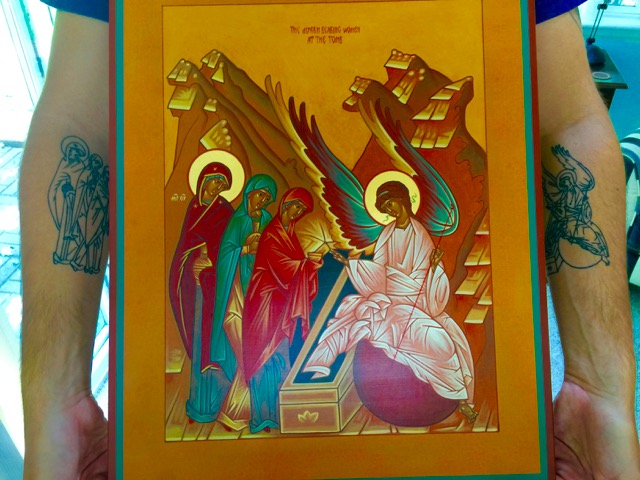
The Reverend Doctor Joe Wolyniak holding the Myrrh-bearing women Icon and exposing his tattoos taken from the icon.
Mark 8:34 “He called the crowd with the disciples, and said to them, `If any want to become my followers, let them take up their cross and follow me.’”
Now, most people immediately jump to the conclusion that Jesus is a divine fortune teller alluding to his death on the cross. Most people think Jesus is talking about the “cross” of the crucifixion or our “crosses we bear” in our sufferings of life. But that is not at all what Jesus is saying.
When Jesus says “take up your cross” the word for cross he is using is “stauros” which is the cross of the letter “T” and not the word for the cross Jesus drags up to Golgotha. When Jesus says “take up your cross” he is saying “take up your identifying mark”. You see, in the first century sheep, slaves and soldiers were branded with a mark to show that they were owned by someone. Usually it was one of two symbols. The most common symbol was what we would call a “T”. It is the Greek letter “Tau” and the “T” branded on the skin, showed that this sheep or soldier or slave was not a free agent but was in the possession of someone.
So truly, one could better translate this passage as “If any want to become my followers, let them deny themselves and take up their identifying mark and follow me.”
When do we get our identifying mark as Christians? We get it at Baptism- that great moment of adjustment. With this new understanding of Jesus’ call to take up our cross, the high moment of the Baptismal service becomes crystal clear. After the person being baptized is lowered into the waters of Baptism or they are poured onto him and after the Priest or Bishop dips her finger into the oil she places it on their forehead and says “You are marked as Christ’s own forever. ” Each of us is marked with the sign of the cross in the same way that sheep, slaves, and soldiers were marked with the “Tau” of ownership.
Of course, one may go further. One may literally mark one’s self as do those who choose tattoos. My friend and colleague Joe enjoys tattoos. They are all of a religious nature and they express his determination to be marked… or inked…as Christ’s now forever.
Recently he was ordained and chose, as his ordination gift, a new tattoo. He had the tattoo artist create the tattoo on his forearms and the image he chose was from an icon written of the Myrrh-bearing women at the tomb on Easter morning. As you may see from the photo of Joe holding he icon, he wanted the images of the women on one arm and the angel on the other.
The women are looking fro their Lord. “Where have you put him? Where has he gone?” they ask, mournfully. In the icon, the artists hints at where Jesus is with the wings of the angel. He is away. He is not in this cuffing, he is away.
But more provocative still is the enclosure of these two forearm images as if Jesus is indeed away, no longer in the tomb. But now in each of us. We are marked as Christ’s own forever. We bear the living Word made flesh in our flesh. We hold Christ the way a lantern holds a flame. The way a man holds an icon.
So the question for you ad me now is this: Can the people around us see Christ in us? Is our lantern clean and clear and bright with Christ’s light or is our lantern smudged, muddy, darkened by greed, or addiction or possessions. I have this feeling. It’s just a feeling. But my hunch is that the early followers of Jesus were so radical, so fiery, so enthusiastic, so passionate about Jesus and the message, that it would be hard not to see their faith, their passion, their modeling of the Christ-life.
Are you and I living a life which says “I am a Christian!” or are we living a life that simply says “I go to church.” What does it mean for you and me, were we not to get tattoos on our forearms, to be marked as Christ’s now forever?


